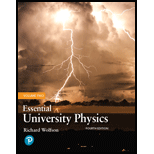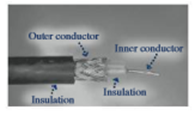
Concept explainers
Coaxial cables are widely used with audio-visual technology, electronic instrumentation, and radio broadcasting, because they minimize interference with or from signals traveling on the cable. Coaxial cables consist of a wire inner conductor surrounded by a thin cylindrical

FIGURE 21.39 A coaxial cable (Passage Problems 76-79)
79. A coaxial cable in electrostatic equilibrium carries charge –Q on its inner conductor and +Q on its shield. If the charge on the shield only is doubled.
- a. the magnitude of the electric field between the conductors will double.
- b. the magnitude of the electric field outside the shield will double.
- c. the magnitude of the electric field at the outer surface of the shield will become twice the magnitude of the field at the shield's inner surface.
- d. the magnitude of the electric field at the outer surface of the shield will equal the magnitude of the field at the shield's inner surface.
Want to see the full answer?
Check out a sample textbook solution
Chapter 21 Solutions
Essential University Physics
Additional Science Textbook Solutions
The Cosmic Perspective
College Physics (10th Edition)
University Physics Volume 1
Tutorials in Introductory Physics
Physics for Scientists and Engineers: A Strategic Approach, Vol. 1 (Chs 1-21) (4th Edition)
- Calculate the electric field entry in row 3 of the following table. (The row numbers are at the edge of the row.) The magnitude of the electric field is |dV/dx|, approximated as a positive ΔV/Δx Voltage Level (Volts) Position (cm) 15.7 7 12.2 5.6 9.5 4.1 6.4 2.9 3.3 1.4 0.0 0 Electric Field (V/cm) Deviation (V/cm) 1 2 3 4 5 Average 6arrow_forwardFind the electric field in a n-type non-conductor if a) Nd = ax, which is a constant value b) Nd = NOexp^ -ax.arrow_forward33. Parts (a) through (e) of this problem should be done by inspection-that is, mentally. The intent is to obtain an approximate solution without a lengthy series of calcula- tions. For the network in Fig. 102: a. What is the approximate value of I1, considering the magnitude of the parallel elements? b. What is the ratio I¡/I2? Based on the result of part (a), what is an approximate value of 12? c. What is the ratio I/I3? Based on the result, what is an approximate value of I3? d. What is the ratio I/I4? Based on the result, what is an approximate value of I4? e. What is the effect of the parallel 100 kN resistor on the above calculations? How much smaller will the current I4 be than the current I¡? f. Calculate the current through the 1 2 resistor using the current divider rule. How does it compare to the result of part (a)? g. Calculate the current through the 10 2 resistor. How does it compare to the result of part (b)? h. Calculate the current through the 1 kn resistor. How does…arrow_forward
- Two small aluminum spheres, each having a mass of 0.0150 kg, are separated by 60.0 cm. (a) How many electrons does each sphere contain? (The atomic mass of aluminum is 26.982 g/mol, and its atomic number is 13.) (b) How many electrons would have to be removed from one sphere and added to the other to cause an attractive force between the spheres of magnitude 1.00 x 10 N (roughly one ton)? Assume that the spheres may be treated as point charges. (c) What fraction of all the electrons in each sphere does this represent?arrow_forwardThe direction of the electric field shown in each part is that produced by the charge distribution in the wire. Justify the direction shown in each part, using the Coulomb force law and the definition of E = F/q, where q is a positive test charge.arrow_forwardThe drift speed of charge carriers in a conductor carrying current / is ngA where n is the number of mobile charge carriers per unit volume, q is the magnitude of the charge on each carrier, and A is the cross-sectional area of the conductor. The transmission line has a diameter of 2.00 cm so that its radius is r= 1.00 cm = 1.0 x 10 m and so that its cross-sectional area is A = nr? - n(1.0 x 10-2 m)² = n x 10-4 m2. In metallic conductors, the mobile charge carriers are electrons, each with a charge of magnitude q- e. We are given the density n of free electrons in this copper material per unit volume. Thus, the drift speed of the electrons is V = ngA c) x 1028 m-1.60 x 10-19 C)(T x 10-4 m2) x 10 m/s.arrow_forward
- Forces in an atom. The particles in the nucleus of an atom are approximately 10- 15 m apart, while the electrons in an atom are about 10- 10 m from the nucleus. (a) Calculate the electrical repulsion between two protons in a nucleus if they are 1.00 x 10- 15 m apart. If you were holding these protons, do you think you could feel the effect of this force? How many pounds would the force be? (b) Calculate the electrical attraction that a proton in a nucleus exerts on an orbiting electron if the two particles are 1.00 x 10- 10 m apart. If you were holding the electron, do you think you could feel the effect of this force?arrow_forwardIn preparation for an experiment that you will do in your introductory nuclear physics lab, you are shown the inside of a Geiger tube. You measure the radius and the length of the central wire of the Geiger tube to be 2.0 x 10-4 m and 1.2 x 10-1 m, respectively. The outer surface of the tube is a conducting cylindrical shell that has an inner radius of 1.5 x 10-2 m. The shell is coaxial with the wire and has the same length (0.12 m). (a) Calculate the capacitance of your tube, assuming that the gas in the tube has a dielectric constant of 1.00. F (b) Calculate the value of the linear charge density on the wire when the potential difference between the wire and shell is of 1.20 kV. C/marrow_forwardMany drugs under development are delivered by nanoparticles in the bloodstream. To monitor changes in the nanoparticles, investigators can retrieve them from the blood by using a device with electrodes that apply oscillating electric fields. The nanoparticles, which are electrically conducting, are strongly attracted to the nearest electrode, while blood cells, which are poor conductors, experience only a weak force toward the nearest electrode,and suspended ions in the blood experience no net force. Explain why the conducting nanoparticles are strongly attracted to the electrodes while other components of the blood are not.arrow_forward
- Two small aluminum spheres, each having mass 0.0250 kg, are separated by 80.0 cm. (a) How many electrons does each sphere contain? (The atomic mass of aluminum is 26.982 g/mol, and its atomic number is 13.) (b) How many electrons would have to be removed from one sphere and added to the other to cause an attractive force between the spheres of magnitude 1.00 * 10^4 N (roughly 1 ton)? Assume that the spheres may be treated as point charges. (c) What fraction of all the electrons in each sphere does this represent?arrow_forwardYour clothing tends to cling together after going through the dryer. Why? Would you expect more or less clinging if all your clothing were made of the same material (say, cotton) than if you dried different kinds of clothing together? Again, why? (You may want to experiment with your next load of laundry.)arrow_forward
 Principles of Physics: A Calculus-Based TextPhysicsISBN:9781133104261Author:Raymond A. Serway, John W. JewettPublisher:Cengage Learning
Principles of Physics: A Calculus-Based TextPhysicsISBN:9781133104261Author:Raymond A. Serway, John W. JewettPublisher:Cengage Learning
